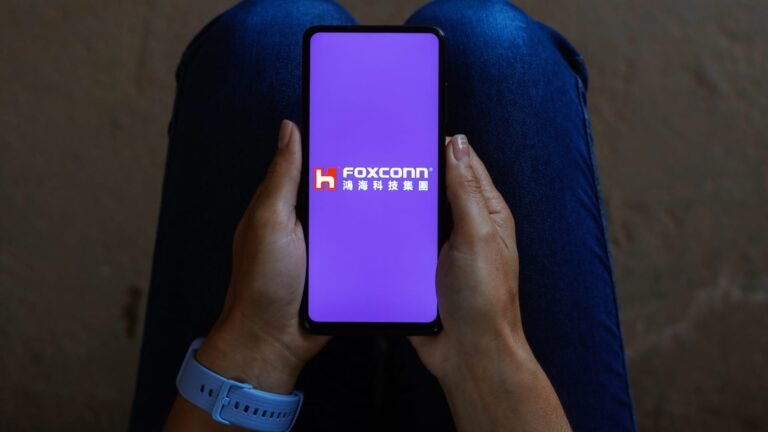
[ad_1]
This month, Foxconn pulled out of its three way partnership with Vedanta. The 2 sides “mutually agreed to half methods,” Foxconn mentioned in a press release on the time.
Sopa Photographs | Lightrocket | Getty Photographs
Foxconn is greatest often called the principle assembler of Apple’s iPhones. However in final couple of years, the Taiwanese agency has made a push into semiconductors, betting that the rise of applied sciences like synthetic intelligence will increase demand for these chips.
However Foxconn’s semiconductor foray has had a tricky begin, highlighting the problem for brand spanking new gamers to enter a market dominated by established corporations with big expertise and a extremely intricate provide chain.
“The business presents newcomers with excessive obstacles to entry, primarily excessive ranges of capital depth and entry to coveted mental property,” Gabriel Perez, ICT analyst at BMI, a unit at Fitch Group, informed CNBC by way of e-mail.
“Established gamers akin to TSMC, Samsung or Micron depend with a number of many years of R&D (analysis and growth), course of engineering and trillions of {dollars} in funding to succeed in their present capabilities.”
Why is Foxconn entering into semiconductors?
Foxconn, formally often called Hon Hai Expertise Group, is a contract electronics producer that assembles shopper merchandise like iPhones. However within the final two years, it has stepped up its presence in semiconductors.
In Might 2021, it shaped a three way partnership with Yageo Company, which makes varied forms of digital elements. That very same yr, Foxconn purchased a chip plant from Taiwanese chipmaker Macronix.
The most important ramp-up in effort got here final yr when Foxconn agreed with Indian metals-to-oil conglomerate Vedanta to arrange a semiconductor and show manufacturing plant in India as a part of a $19.5 billion three way partnership.
Neil Shah, vp of analysis at Counterpoint Analysis, mentioned Foxconn’s push into semiconductors is about diversifying its enterprise, and the corporate’s determination to launch an electric car unit is a part of that plan. Its goal is to grow to be a “one cease store” for electronics and automotive firms, Shah mentioned.
If Foxconn may assemble electronics and manufacture chips, it might be a really distinctive and aggressive enterprise.
Why India?
Foxconn seemed to India for its three way partnership with Vedanta as a result of the nation’s authorities is trying to boost its domestic semiconductor industry and convey manufacturing on shore.
“Foxconn’s determination to ascertain a JV in India responds to 2 key traits – one among them being the market’s rising position as a shopper electronics manufacturing hub, the second being India’s ambitions – mirroring different main markets such because the US, the EU and Mainland China – to develop its home semiconductor business by means of public subsidies and regulatory incentives,” BMI’s Perez mentioned.
What went incorrect for Foxconn?
This month, Foxconn pulled out of its three way partnership with Vedanta. The 2 sides “mutually agreed to half methods,” Foxconn mentioned in a press release on the time.
“There was recognition from each side that the venture was not transferring quick sufficient, there have been difficult gaps we weren’t capable of easily overcome, in addition to exterior points unrelated to the venture,” Foxconn mentioned.
Deadlocked talks with European chipmaker STMicroelectronics, which was the expertise associate for the venture, was one main cause for the enterprise’s failure, Reuters reported this month.
Foxconn and Vedanta wished to license the expertise from STMicro and India wished the agency to have a stake within the three way partnership, however the European chipmaker didn’t, Reuters reported.
It is arduous to interrupt into chipmaking
Foxconn’s hurdles level to a broader subject — it is arduous for newcomers to get into semiconductor manufacturing.
The manufacturing of chips is dominated by one participant — Taiwan Semiconductor Manufacturing Firm, higher often called TSMC — which has a 59% market share within the foundry phase, in line with Counterpoint Analysis.
TSMC would not design its personal chips. As a substitute, it makes these elements for different firms like Apple. TSMC has had greater than twenty years of expertise and billions of {dollars} of funding to get to where it is.
TSMC additionally depends on a complex supply chain of companies that make vital instruments to permit it to fabricate probably the most superior chips on the planet.
Foxconn and Vedanta’s effort appeared to rely closely on STMicro, however as soon as the European firm bailed, the three way partnership was with out a lot experience in semiconductors.
“Each firms … lacked the core competency of producing a chip,” Counterpoint Analysis’s Shah mentioned, including that they have been depending on third-party expertise and mental property.
Foxconn’s makes an attempt to crack the semiconductor area spotlight how troublesome it’s for a brand new entrant to take action — even for a $47.9 billion large.
“The semiconductor market is extremely concentrated with few gamers which have taken greater than twenty years to evolve up to now,” Shah mentioned, including that there are excessive obstacles to entry, akin to massive quantities of funding and specialised labor.
“On a mean, it takes greater than twenty years to be on the degree of ability and scale to be a profitable semiconductor manufacturing (fab) firm.”
[ad_2]